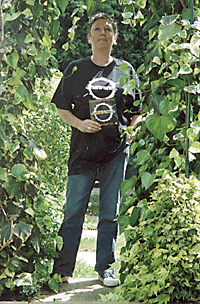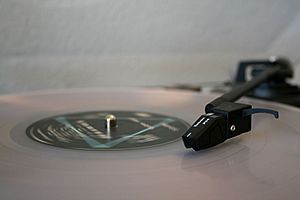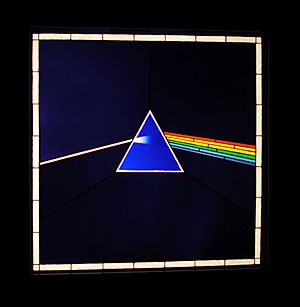The Dark Side of the Moon facts for kids
Quick facts for kids The Dark Side of the Moon |
||||
|---|---|---|---|---|
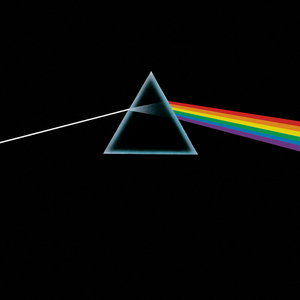 |
||||
| Studio album by | ||||
| Released | 1 March 1973 | |||
| Recorded | 31 May 1972 – 9 February 1973 | |||
| Studio | EMI, London | |||
| Genre | Progressive rock | |||
| Length | 42:50 | |||
| Label |
|
|||
| Producer | Pink Floyd | |||
| Pink Floyd chronology | ||||
|
||||
| Singles from {{{Name}}} | ||||
The Dark Side of the Moon is the eighth studio album by the English rock band Pink Floyd. It was released on March 1, 1973, in the UK and US. The band developed the songs during live shows before recording them. They wanted to create a concept album, which is an album where all the songs are connected by a main idea. This album focused on the challenges the band faced during their busy lives. It also touched on the difficulties faced by their former band member, Syd Barrett, who left the group in 1968. The new music was recorded in London at EMI Studios (now Abbey Road Studios) in 1972 and 1973.
The album built on ideas from Pink Floyd's earlier music. However, it did not have the very long instrumental parts that were common in their older songs. The band used special recording methods like multitrack recording (recording many layers of sound). They also used tape loops (repeating sounds) and analogue synthesisers, including the EMS VCS 3 and Synthi A. Engineer Alan Parsons helped a lot with the sound of the album. He also found session singer Clare Torry, who sang on the song "The Great Gig in the Sky".
The Dark Side of the Moon explores ideas like conflict, money, time, death, and mental well-being. The album includes short clips from interviews with the band's road crew (people who help with tours) and others. The album cover shows a prismatic spectrum (light splitting into colors). Storm Thorgerson designed it after keyboardist Richard Wright asked for a "simple and bold" look. This design represented the band's stage lighting and the album's themes. Two songs from the album, "Money" and "Us and Them", were released as singles to promote it.
The Dark Side of the Moon is one of the most praised albums ever made. It often appears on lists of the greatest albums of all time. It made Pink Floyd famous around the world and brought them great success. The album sold over 45 million copies worldwide by 2013. This makes it the best-selling album of the 1970s and the fourth-best-selling album in history. In 2012, the album was chosen to be kept in the United States National Recording Registry. This means it is considered "culturally, historically, or aesthetically significant." In 1999, The Dark Side of the Moon was added to the Grammy Hall of Fame.
Contents
Creating the Album
After their 1971 album Meddle, Pink Floyd went on tour in Britain, Japan, and the United States. During a meeting at drummer Nick Mason's house, bassist Roger Waters suggested that a new album could be part of their tour. Waters wanted to create an album about the pressures and challenges people face in life. He also wanted to explore the difficulties that their former band member, Syd Barrett, had experienced. The band had thought about similar ideas before in their 1969 concert show, The Man and The Journey.
Guitarist David Gilmour said that the band wanted the lyrics to be very clear. The band liked Waters' idea for an album with one main theme. Waters, Gilmour, Mason, and keyboardist Richard Wright all helped write and produce the new songs. Waters made early demo (practice) versions of the songs in a small studio at his home. Some parts of the album came from older music the band had not used yet. For example, the start of "Breathe" came from a song Waters and Ron Geesin wrote for a film soundtrack. The main idea for "Us and Them" came from an older song by Wright.
The band practiced in a warehouse owned by the Rolling Stones and at the Rainbow Theatre in London. They also bought new equipment, including speakers and a special mixing desk. They even had a custom lighting system. Nine tons of equipment were moved in three lorries. This was the first time the band toured with an entire album's worth of new music. The album was first called Dark Side of the Moon. This name hinted at mental challenges, not just space. But when another band, Medicine Head, used that title, Pink Floyd temporarily changed theirs to Eclipse. The new music was first played in Brighton on January 20, 1972. After Medicine Head's album did not sell well, Pink Floyd changed the title back to their first choice.
Early Performances
The album, then called Dark Side of the Moon: A Piece for Assorted Lunatics, was played for the press on February 17, 1972. This was more than a year before it was officially released. Critics generally liked it. Michael Wale of The Times said it was "bringing tears to the eyes." However, Melody Maker was less impressed, saying the sound effects made them feel like they were "in a bird-cage at London Zoo." The tour that followed was very popular with the public. The new songs were played in the same order they would appear on the album. Some differences included "On the Run" not having synthesizers yet. Also, Clare Torry's vocals on "The Great Gig in the Sky" were replaced by Bible readings at first.
Pink Floyd's long tour through Europe and North America helped them improve their live shows. Work on the album was paused in February when the band went to France. There, they recorded music for the film La Vallée. They played shows in Japan, finished the film in France, and then played more shows in North America. Finally, they returned to London in May and June to continue recording. After more concerts, the band came back to London on January 9, 1973, to finish the album.
Album Themes
The Dark Side of the Moon built on ideas Pink Floyd had tried in their past shows and recordings. However, it did not have the very long instrumental parts that had become common after founding member Syd Barrett left in 1968. Guitarist David Gilmour and bassist Roger Waters said their 1971 album Meddle was a turning point for the sound of The Dark Side of the Moon. The album's songs explore themes like conflict, greed, the passing of time, death, and mental well-being. The last theme was partly inspired by Barrett's declining mental state. The album also uses musique concrète, which means using recorded sounds from everyday life.
Each side of the vinyl album plays as one continuous piece of music. The five songs on each side represent different parts of human life. The album starts and ends with a heartbeat sound. It explores what it means to be human and, as Waters said, "empathy" (understanding others' feelings). "Speak to Me" and "Breathe" together show the everyday, sometimes pointless, parts of life. They also show the constant worry of losing one's mind and how important it is to live your own life. The message is: "Don't be afraid to care."
"On the Run" is an instrumental song driven by synthesizers. It creates the feeling of stress and worry from modern travel. "Time" looks at how time controls our lives. It warns those who only focus on everyday things. After "Time" comes "Breathe (Reprise)", which is about finding peace alone. The first side of the album ends with "The Great Gig in the Sky." This song, with Wright's piano and Clare Torry's vocals, is a powerful way to think about death.
"Money", the first song on side two, starts with sounds of cash registers and coins. The song makes fun of greed and consumerism (buying lots of things) with sarcastic words and money-related sounds. "Money" became the band's most successful song and other artists have covered it. "Us and Them" talks about feeling alone when you are sad. It uses simple opposite ideas to describe relationships. "Any Colour You Like" suggests that the choices we think we have in society might not be real.
"Brain Damage" explores mental difficulties that can come from focusing too much on fame and success instead of your own needs. The line "and if the band you're in starts playing different tunes" refers to the mental breakdown of former bandmate Syd Barrett. The album ends with "Eclipse." This song talks about being different but also connected. It encourages listeners to see the common things all people share.
Making the Music
The Dark Side of the Moon was recorded at EMI Studios (now Abbey Road Studios). It took about 60 days between May 31, 1972, and February 9, 1973. Pink Floyd worked with engineer Alan Parsons. He had helped with their earlier album Atom Heart Mother (1970). Parsons also had experience working on the Beatles' albums Abbey Road and Let It Be.
The recording sessions for Dark Side of the Moon used advanced studio techniques. The studio could record 16 separate tracks, which gave the band more freedom than the 8- or 4-track recordings they used before. However, the band often used so many tracks that they had to make copies to free up space on the tape. Mix supervisor Chris Thomas later remembered that the band was very efficient. They used only a few tracks for drums, guitars, keyboards, and bass.
The first song recorded was "Us and Them" on May 31. "Money" was recorded seven days later. For "Money," Waters made sound loops from recordings of money sounds. These included coins dropped into a mixing bowl at his wife's pottery studio. These sounds were re-recorded to create a special quadraphonic mix (a mix for four speakers).
"Time" and "The Great Gig in the Sky" were recorded next. Then, the band took a two-month break to be with their families and get ready for a US tour. The recording sessions were often interrupted. Waters, who supported Arsenal F.C., would take breaks to watch his team play. The band would also stop to watch Monty Python's Flying Circus on TV while Parsons worked. Gilmour said, "...but when we were on a roll, we would get on."
After returning from the US in January 1973, they recorded "Brain Damage," "Eclipse," "Any Colour You Like," and "On the Run." They also perfected earlier recordings. Four female singers were brought in for "Brain Damage," "Eclipse," and "Time." Saxophonist Dick Parry played on "Us and Them" and "Money." The band also filmed studio footage for Pink Floyd: Live at Pompeii. Once recording was done, the band started a tour of Europe.
Instruments and Sounds
The album uses rhythmic sound effects in "Speak to Me" and tape loops for the start of "Money." Mason created an early version of "Speak to Me" at home before finishing it in the studio. This song acts as an overture (an introduction) and blends sounds from other songs on the album. A piano chord played backward adds to the build-up of effects, which then lead into "Breathe." Mason received a rare solo writing credit for "Speak to Me."
The sound effects on "Money" were made by combining Waters' recordings of clinking coins, tearing paper, a ringing cash register, and a clicking adding machine. These were used to create a repeating 7-beat sound loop. This was later changed for four speakers to make the sound seem to "walk around the room." Sometimes, the album's sound experiments needed the engineers and all four band members to control the mixing board at the same time. This was especially true for songs like "On the Run."
Pink Floyd also used many synthesizers in their music. They experimented with an EMS VCS 3 on "Brain Damage" and "Any Colour You Like." They used a Synthi A on "Time" and "On the Run." They also created unusual sounds. For example, assistant engineer Peter James ran around the studio's echo chamber during "On the Run." A specially treated bass drum was used to sound like a human heartbeat in "Speak to Me," "On the Run," "Time," and "Eclipse." This heartbeat is clearest at the beginning and end of the album. "Time" starts with many clocks ticking and chiming together, along with Rototoms (a type of drum). These clock sounds were originally recorded by Parsons as a test at an antique clock shop.
Voices and Interviews
Songs like "Us and Them" and "Time" showed how well Wright and Gilmour could sing together. Engineer Alan Parsons used techniques like double tracking vocals and guitars. This allowed Gilmour to sing harmonies with himself. They also used flanging and phase-shifting effects on voices and instruments. Sounds were moved between speakers, especially in the quadraphonic mix of "On the Run." Here, the sound of the Hammond B3 organ played through a Leslie speaker swirled around the listener.
Wright's "The Great Gig in the Sky" features Clare Torry, a session singer who often worked at Abbey Road. Parsons liked her voice. When the band decided to use a female singer, he suggested Torry. The band explained the album's idea to her. However, they could not tell her exactly what to sing. Gilmour, who was in charge, asked her to express emotions instead of singing words. In a few tries on a Sunday night, Torry sang a wordless melody with Wright's emotional piano solo. She was at first embarrassed by how loud she was in the recording booth. She wanted to apologize to the band, but they were very impressed. Her recordings were edited to make the version used on the song. She left the studio thinking her vocals would not be used. She only found out she was on the album when she bought it and saw her name in the credits. She was paid her usual fee of £30 for her work.
In 2004, Clare Torry sued the record company and Pink Floyd. She argued that her singing on "The Great Gig in the Sky" was so important that she should be considered a co-writer of the song. The case was settled outside of court for an unknown amount of money. Since 2005, newer versions of the album credit Wright and Torry as co-writers.
In the last week of recording, Waters asked staff and others at Abbey Road to answer questions. Their replies were edited into the final music. The interviewees were in a dark studio and shown questions like "What's your favourite colour?" and "What's your favourite food?" Then, they were asked about the album's main themes, like mental well-being and death. Questions like "When was the last time you were violent?" followed by "Were you in the right?" were answered in order.
The band's road manager Peter Watts (father of actress Naomi Watts) provided the repeated laughter in "Brain Damage" and "Speak to Me." His second wife, Patricia "Puddie" Watts, said the line about the "geezer" who was "cruisin' for a bruisin'" (looking for a fight). This line is used between "Money" and "Us and Them." She also said, "I never said I was frightened of dying" in "The Great Gig in the Sky."
Some of the most famous answers came from the studio's Irish doorman, Gerry O'Driscoll. He said: "I am not frightened of dying. Any time will do, I don't mind. Why should I be frightened of dying? There's no reason for it ... you've got to go sometime." He also said, "I know I've been mad, I've always been mad, like most of us have." The album ends with his words: "There is no dark side in the moon really. Matter of fact, it's all dark." Parsons said that O'Driscoll also added, "The only thing that makes it look alight is the sun." But the band loved his first line so much that they didn't include the rest.
Paul and Linda McCartney were also interviewed, but their answers were not used. The band felt they were "trying too hard to be funny."
Final Touches
When the interview sessions were done, producer Chris Thomas was hired to give "a fresh pair of ears" to the final mix. Thomas knew music well and had worked with Beatles producer George Martin. The band members reportedly disagreed about the mix. Waters and Mason wanted a "dry" and "clean" sound with more non-musical elements. Gilmour and Wright preferred a softer, more "echoey" mix. Thomas said later that there were no major disagreements. He described it as a "very creative atmosphere."
Thomas's help led to a compromise that both Waters and Gilmour liked. Thomas made important changes, like perfectly timing the echo on "Us and Them." He was also there for the recording of "The Great Gig in the Sky." Waters said in a 2006 interview that when the album was finished, he played it for his wife. He remembered her crying when it ended. He thought, "This has obviously struck a chord somewhere." He felt confident that people would connect with the album.
Album Art
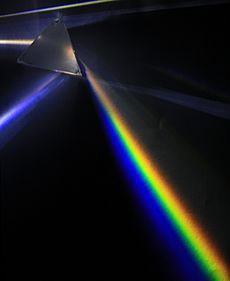
The album was first released in a gatefold LP sleeve. This means the cover opened up like a book. It was designed by Hipgnosis and George Hardie. Hipgnosis had designed several of Pink Floyd's previous album covers, sometimes with surprising results. EMI, the record company, was confused by the covers for Atom Heart Mother and Obscured by Clouds. They expected traditional designs with words and titles. But designers Storm Thorgerson and Aubrey Powell were hired directly by the band, so they could ignore such criticism.
For The Dark Side of the Moon, Richard Wright wanted something "smarter, neater... more classy," and simple. He suggested something like the artwork on a Black Magic chocolate box. The design was inspired by a photo Thorgerson found in a physics textbook from 1963. This photo showed a prism splitting white light into colors. It was also inspired by an illustration by Alex Steinweiss, who invented album cover art. George Hardie, from Hipgnosis, created the artwork. Hipgnosis offered seven designs, but all four band members agreed the prism was the best. Roger Waters said, "There were no arguments. We all pointed to the prism and said 'That's the one'."
The design shows a glass prism splitting light into colors. It represents three things: the band's stage lighting, the album's lyrics, and Wright's request for a "simple and bold" design. Waters suggested that the light spectrum should continue onto the inside of the gatefold cover. The gatefold also includes a visual image of the heartbeat sound used in the album. The back of the album cover shows another prism putting the light spectrum back together. This allowed for interesting ways to display the album in record stores. The light coming from the prism on the cover has six colors, missing indigo, compared to the usual seven colors of the spectrum. Inside the album sleeve were two posters and two pyramid-themed stickers. One poster had pictures of the band in concert, with scattered letters forming PINK FLOYD. The other was an infrared photograph of the Great Pyramids of Giza.
The band was so confident in Waters' lyrics that, for the first time, they printed them on the album's sleeve.
Album Release
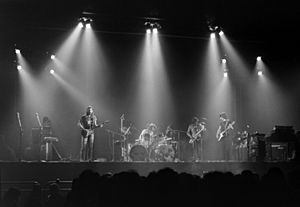
(left to right) David Gilmour, Nick Mason, Dick Parry, Roger Waters
The quadraphonic mix of the album was not ready yet, so the band (except Wright) did not attend the press event on February 27. Instead, guests saw life-sized cardboard cut-outs of the band. The stereo mix of the album was played over a poor sound system. Still, the press was mostly positive. Roy Hollingworth of Melody Maker praised Side Two, saying: "The songs, the sounds, the rhythms were solid and sound." Steve Peacock of Sounds wrote: "I'd unreservedly recommend everyone to The Dark Side of the Moon." Loyd Grossman of Rolling Stone called it "a fine album with a textural and conceptual richness that not only invites, but demands involvement."
The Dark Side of the Moon was released in the US on March 1, 1973, and in the UK on March 16. It quickly became a hit in Britain and Europe. By the next month, it had earned a gold certification in the US. Throughout March 1973, the band played the album during their US tour. This included a midnight show in New York City for 6,000 people. The album reached number one on the US Billboard Top LPs & Tape chart on April 28, 1973. It was so successful that the band returned two months later for another tour.
Record Label Efforts
Much of the album's early success in America was due to Capitol Records, Pink Floyd's US record company. The new chairman, Bhaskar Menon, worked hard to improve the band's sales. Pink Floyd and their manager, Steve O'Rourke, were quietly talking about a new contract with CBS president Clive Davis at Columbia Records. The Dark Side of the Moon was the last album Pink Floyd had to release before signing their new deal. Menon was so excited about the new album that he started a huge advertising campaign. This included shorter, radio-friendly versions of "Us and Them" and "Time."
In some countries, like the UK, Pink Floyd had not released a single since 1968. But "Money" was released as a single on May 7, with "Any Colour You Like" on the B-side. It reached number 13 on the US Billboard Hot 100 in July 1973. A special two-sided promotional single was sent to radio stations. On February 4, 1974, a double A-side single was released with "Time" on one side and "Us and Them" on the other. However, Menon's efforts to keep Pink Floyd with Capitol failed. In early 1974, the band signed with Columbia for a reported $1 million advance. In Britain and Europe, they continued to be with Harvest Records.
Album Sales
The Dark Side of the Moon became one of the best-selling albums of all time. It is also in the top 25 of best-selling albums in the United States. Even though it was only number one in the US for one week, it stayed on the Billboard 200 albums chart for 736 non-stop weeks. This was from March 17, 1973, to July 16, 1988. It reappeared on the charts later and by May 2023, it had been on the chart for 981 weeks. In a slow week, between 8,000 and 9,000 copies are still sold. As of April 2013, the album had sold over 9.5 million copies in the US since 1991. It is estimated that one in every fourteen people in the US under 50 years old owns, or has owned, a copy.
The Dark Side of the Moon was released before platinum certification was introduced in 1976. So, it only had a gold certification until February 16, 1990, when it became 11 times platinum. On June 4, 1998, it was certified 15 times platinum, meaning 15 million copies sold in the US. This makes it Pink Floyd's best-selling album there. "Money" has sold well as a single and, like "Time," is still popular on the radio. In 2017, The Dark Side of the Moon was the seventh-best-selling album of all time in the UK. It was also the highest-selling album that never reached number one there. In 2013, experts said that worldwide sales of The Dark Side of the Moon totaled about 45 million copies.
In 1993, Gilmour said the album's success came from combining the music, lyrics, and cover art. Mason said that when they finished the album, Pink Floyd felt it was their best work. But they were surprised by how well it sold. He said it was "not only about being a good album but also about being in the right place at the right time."
Later Versions
In 1979, The Dark Side of the Moon was re-released as a remastered LP. It was also released on CD in Japan in 1983 and in the US and Europe in 1984. In 1992, it was re-released as a remastered CD in a box set called Shine On. This version was re-released as a 20th-anniversary box set in 1993. On some versions, a quiet orchestral version of the Beatles' "Ticket to Ride" can be heard after "Eclipse."
30th Anniversary Edition
For the album's 30th anniversary, a new surround sound version was released in 2003. The band chose not to use Alan Parsons' original quadraphonic mix. Instead, engineer James Guthrie created a new 5.1 channel mix for the SACD format. Guthrie had worked with Pink Floyd since their album The Wall. Parsons said he was "possibly a little too true to the original mix" but still praised it. The 30th-anniversary edition won four Surround Music Awards in 2003. It sold over 800,000 copies.
The cover image for the 30th-anniversary edition was created by a team including Thorgerson. It is a photo of a custom-made stained glass window. This window was built to look like the original prism design. Clear glass was used instead of the original opaque colors. This idea came from the "sense of purity in the sound quality, being 5.1 surround sound." The image was made to be "the same but different," so it was clearly Dark Side of the Moon but also new.
Recent Reissues
The Dark Side of the Moon was re-released in 2003 on high-quality vinyl. It included slightly different versions of the posters and stickers from the original release. In 2007, the album was part of Oh, by the Way, a box set celebrating Pink Floyd's 40th anniversary. A version without DRM was released on the iTunes Store. In 2011, it was reissued with a remastered version and other materials.
In 2023, Pink Floyd announced The Dark Side of the Moon 50th Anniversary box set. This set includes a newly remastered album, surround sound mixes (including a new Dolby Atmos mix), a photo book, and The Dark Side of the Moon Live at Wembley 1974 on vinyl.
Album's Impact
The album's success brought a lot of money to all four band members. Richard Wright and Roger Waters bought large country houses. Nick Mason became a collector of expensive cars. Some of the profits were even invested in making the movie Monty Python and the Holy Grail. Engineer Alan Parsons was nominated for a Grammy Award for his work on The Dark Side of the Moon. He later had a successful career with the Alan Parsons Project. While Waters and Gilmour sometimes downplay his role, Mason has praised his contribution. In 2003, Parsons said, "I still wake up occasionally, frustrated about the fact that they made untold millions and a lot of the people involved in the record didn't."
The Dark Side of the Moon has had a big impact on modern music. It has influenced many musicians who have covered its songs. It is often seen as a key moment in rock music history. People sometimes compare it to Radiohead's 1997 album OK Computer. Some believe both albums share a theme that "the creative individual loses the ability to function in the [modern] world."
In 2013, The Dark Side of the Moon was chosen for preservation in the United States National Recording Registry. This means the Library of Congress considers it "culturally, historically, or aesthetically significant." In early 2023, Roger Waters announced he had recorded a new version of The Dark Side of the Moon. It will have spoken-word parts and no guitar solos. He said this was to "bring out the heart and soul of the album musically and spiritually."
Top Rankings
The Dark Side of the Moon often appears on lists of the greatest albums. In 1987, Rolling Stone ranked it the 35th best album of the previous 20 years. Rolling Stone ranked it number 43 on its 2003 and 2012 lists of the "Rolling Stone's 500 Greatest Albums of All Time" and number 55 in its 2020 list. This is Pink Floyd's highest spot on that list. Both Rolling Stone and Q have called The Dark Side of the Moon the best progressive rock album.
In 2006, viewers of the Australian Broadcasting Corporation voted The Dark Side of the Moon their favorite album. NME readers voted it the eighth-best album in a 2006 poll. In 2009, Planet Rock listeners voted it the greatest album of all time. The album is also number two on the "Definitive 200" list of albums. This list was made by the National Association of Recording Merchandisers to celebrate album art. It ranked 29th in The Observer's 2006 list of "The 50 Albums That Changed Music." It was 37th in The Guardian's 1997 list of the "100 Best Albums Ever." In 2014, readers of Rhythm voted it the seventh most influential progressive drumming album. It was voted number 9 in Colin Larkin's All Time Top 1000 Albums 3rd Edition (2000).
The album's cover has also received praise. VH1 called it the fourth greatest album cover in history.
Covers and Tributes
Return to the Dark Side of the Moon: A Tribute to Pink Floyd, released in 2006, is an album of cover songs from The Dark Side of the Moon. It features artists like Adrian Belew and Rick Wakeman. In 2000, The Squirrels released The Not So Bright Side of the Moon, which covers the entire album. The New York dub group Easy Star All-Stars released Dub Side of the Moon in 2003. The group Voices on the Dark Side released Dark Side of the Moon a Cappella, a full a cappella (voices only) version of the album. The bluegrass band Poor Man's Whiskey often plays the album in a bluegrass style. A string quartet version of the album was released in 2003. In 2009, the Flaming Lips released a remake of the album, song by song.
Many famous bands have played the entire album live. Also, many artists have used samples (small parts of recordings) from The Dark Side of the Moon in their own music. The band Phish played a mostly improvised version of the album in 1998. Progressive metal band Dream Theater has covered the album live twice. In May 2011, Mary Fahl released From the Dark Side of the Moon, which was her own version of the album. Milli Vanilli used the tape loops from Pink Floyd's "Money" to start their song "Money." Marky Mark and the Funky Bunch also used them in their album Music for the People.
The Wizard of Oz Connection
In the 1990s, people noticed that if you played The Dark Side of the Moon at the same time as the 1939 film The Wizard of Oz, there seemed to be moments where they matched up. Some thought this might have been on purpose. For example, Dorothy starts to jog when the song "Time" says "no one told you when to run." She balances on a fence during the line "balanced on the biggest wave" in "Breathe." She puts her ear to the Tin Man's chest as the album's closing heartbeats are heard. However, Alan Parsons and members of Pink Floyd have said there is no connection. Parsons called it "a complete load of eyewash." He said that if you play any record with the TV sound off, you will find things that seem to match.
Track Listing
All lyrics written by Roger Waters.
| No. | Title | Lead vocals | Length |
|---|---|---|---|
| 1. | "Speak to Me" | instrumental | 1:07 |
| 2. | "Breathe" (In the Air) | Gilmour | 2:49 |
| 3. | "On the Run" | instrumental | 3:45 |
| 4. | "Time" |
|
6:53 |
| 5. | "The Great Gig in the Sky" | Torry | 4:44 |
| 6. | "Money" | Gilmour | 6:23 |
| 7. | "Us and Them" | Gilmour | 7:49 |
| 8. | "Any Colour You Like" | instrumental | 3:26 |
| 9. | "Brain Damage" | Waters | 3:46 |
| 10. | "Eclipse" | Waters | 2:12 |
|
Total length:
|
43:09 | ||
Note
- Since the 2011 remasters, and the Discovery box set, "Speak to Me" and "Breathe (In the Air)" are listed as separate songs.
Personnel
Pink Floyd
- David Gilmour – vocals, guitars, Synthi AKS
- Nick Mason – drums, percussion, tape effects
- Roger Waters – bass guitar, vocals, VCS 3, tape effects
- Richard Wright – organ (Hammond and Farfisa), piano, electric piano (Wurlitzer, Rhodes), EMS VCS 3, Synthi AKS, vocals
|
Additional Musicians
|
Production Team
Design Team
|
Images for kids
-
The Rainbow Theatre in London, where The Dark Side of the Moon was played for the press in 1972.
See also
 In Spanish: The Dark Side of the Moon para niños
In Spanish: The Dark Side of the Moon para niños




